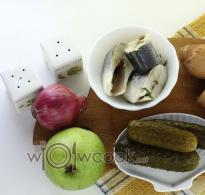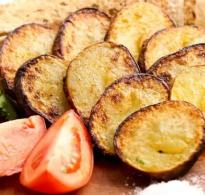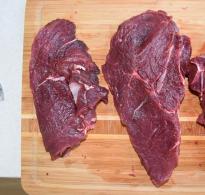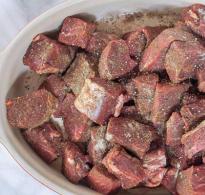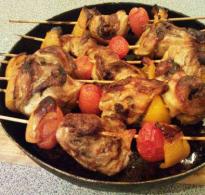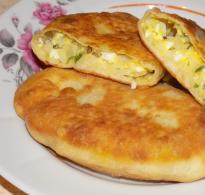100 g of sugar in tablespoons. How to measure the required amount of granulated sugar with a tablespoon and a teaspoon? Spoons and glasses to help
Often, cookbooks list the amount of ingredients required in grams. We think it is superfluous to talk about the risks of non-observance of proportions, since every hostess knows this herself well. Of course, measuring the right amount is not difficult if you have a scale in your kitchen. But what if there is no such gadget, and the recipe says "Take 100 grams of sugar"? In no case do not despair, but rather read this post to the end, because today we will give you a lot of advice on how to measure 100 grams of granulated sugar without weights.
We have already decided that you do not have scales, but it is possible that you have a measuring cup. Such dishes have serifs that will help determine how much substance is in the glass. If milliliters were taken as a unit of measurement, then it will not be difficult to navigate by them, since 100 ml of sugar contains almost the same grams.
If you do not have a measuring cup, you can use a regular, 250 ml. A glass filled to the top contains 250 grams of sugar, if the sugar limit coincides with the risk, then this is about 200 grams. From this it follows that by filling a faceted glass with sugar in half, you will get the very necessary 100 grams.
If you don't even have a glass in your arsenal, although this is difficult to imagine, then you can measure 100 grams of sugar with a tablespoon. A heaping tablespoon filled with sugar contains 25 grams of product... With the help of simple mathematical calculations, we can conclude that 4 tablespoons of sugar is just as much as the recipe requires. If the tablespoon was without a slide, then in order to comply with the proportions indicated in the cookbook, you will have to put 5 spoons.
100 grams of sugar can be measured with a dessert spoon(this is the one that is slightly smaller than the dining room and slightly larger than the tea room). A dessert spoon filled with a top holds 15 grams of sugar, without a top - 10 grams. Thus, in the dough (or for what you needed to measure 100 grams of sugar), you will have to put 6.5 and 10 spoons, respectively.
As a last resort, if all of the above methods for some reason do not suit you, you can measure 100 grams of sugar with a teaspoon. Of course, this procedure will be somewhat more time consuming, but this will in no way affect the accuracy of the results. A heaped teaspoon filled with sugar will weigh 7 grams (net weight, of course), which means you will have to scoop up the spoon from the sugar bowl 14.5 times to get the required amount. If you fill a teaspoon without a slide, then even more manipulations will be required, namely 20, since a teaspoon filled to the top, but without a slide, holds 5 grams of sugar.
As you can see, dear visitors of our portal, even if you do not have scales, you can measure 100 grams of sugar with the help of improvised means that are sure to be in any kitchen.
Experienced housewives rarely use a measuring cup or kitchen scale, since everything is done by eye. However, some complex dishes require impeccable proportions, such as pastries and desserts. In this case, you can use an ordinary glass or spoon, as our mothers and grandmothers once did. And, by the way, they got the finest lace pancakes, ruddy pies, crumbly cookies and perfectly baked tender biscuits that were eaten very quickly. Measuring weight at home is simple - a thin and faceted glass, a teaspoon and a tablespoon. Let's talk about how many products fit in these containers.
We measure products in a glass

The measure of weight in a glass depends on which glass you use - thin or faceted, since they are different from each other. The faceted glass has a volume of 200 ml, several edges and a rounded rim. The thin glass is absolutely smooth and has a capacity of 250 ml. Liquids (water, wine, milk, juice, cream) are easy to measure, and bulk products with the same volume have different weights, which greatly complicates the measurement process. For this, a table of measures of weight of products is needed - with it you can never go wrong and measure out exactly as much sugar and flour as is required for a cake or cookies.
Comparing products, we will indicate the quantity in a faceted (first digit) and thin glass (second digit). For example, one glass holds 140–175 g of wheat flour, 180–220 g of granulated sugar, 190–230 g of vegetable oil, 185–240 g of melted butter, 250–300 g of condensed milk and 270–330 g of jam. As for cereals, then 70–90 g of rolled oats, 170–210 g of buckwheat, 150–200 g of semolina, 190–230 g of rice, peas, beans, millet, barley, barley and small pasta can be poured into a glass. It will fit 130-140 g of crushed nuts, 130-160 whole almonds and hazelnuts, 265-325 g of honey, 210-250 g of sour cream, 250-300 g of tomato paste and 100-125 g of ground crackers.
A little about the measures of weight in a tablespoon and a teaspoon

It is difficult to imagine how you can measure out five glasses of flour or a liter of milk with spoons, so this cutlery is suitable for measuring small amounts of food. For example, if you need very little flour for airy cakes, béchamel sauce, vegetable, meat, or fish cakes, you can use a teaspoon or tablespoon.
One tablespoon is 18 g of liquid, 25 g of rolled oats, sugar, semolina, buckwheat, barley, millet and rice. You can quite count on the fact that a spoon will fit 17 g of vegetable or melted butter, 30 g of flour, salt and ground nuts, 25 g of sour cream and cocoa powder, 20 g of milk powder, 30 g of starch and honey. You will get only 15 g of ground crackers, but you can scoop 50 g of jam with a tablespoon. With a miniature teaspoon, you will be able to measure 10 g of sugar, starch and sour cream, 8 g of flour, 9 g of cocoa, 7 g of honey, 5 g of vegetable oil and milk. A teaspoon also contains 10 g of nut kernels, 17 g of jam, about 5 g of cereals and peas, 2-4 g of cereal flakes.
Accuracy - the politeness of kings

To measure the weight of products without weights, you need to follow some rules that will help you strictly follow the recipe. For appetizers, soups, main courses and side dishes, this is not so critical. However, in some cases, such as when baking bread, the wrong ratio of liquid to flour can slow down fermentation. With a lack of moisture, the dough does not rise well, and the bread has a dry crumbly texture. If, on the contrary, there is too much moisture, the baked goods turn out to be heavy, blurry, with a damp and sticky crumb.
We measure products correctly

How to use home weight measures correctly? Containers should be filled with liquid products to the limit, that is, to the very edges. It is more convenient to apply viscous and thick mixtures (honey, jam, sour cream) with a spoon, making sure that the glass is completely filled. Fill containers with loose and viscous products with a slide, and do not scoop flour and starch directly from a bag or bag, but pour it with a spoon so that voids do not form. You do not need to shake, loosen and tamp the food, and if you need to sift flour, do it after measurements. The fact is that when sifting, the flour becomes more voluminous, which means that its weight will also change. For comparison: a thin glass contains 160 g flour when properly filled, 210 g tamped flour and 125 g sifted flour. Changes in the characteristics of products also affect their weight - for example, an increase in moisture makes salt, sugar and flour heavier, and fermented sour cream is lighter when fresh.
What to replace

If you do not have a tea and faceted glass, take any container, measure its volume using accurate ones and mark the line where the volume will be 200 or 250 ml. For culinary purposes, you can also use standard plastic cups with a capacity of 200 ml. Usually in recipes instead of the phrase "tea glass" they simply write "glass" or "cup", which means 250 ml. If a faceted glass serves as a measure of weights, then this will certainly be indicated in the recipe.
Culinary arithmetic

You don't need to keep dozens of numbers in your head to prepare a delicious dish and not go crazy with mathematical calculations. It is enough to have a table of measures of weight in spoons and glasses in the kitchen. If you see an instruction in a recipe to take half or a quarter of a glass of some product, for example sugar, then, having a table, you can easily convert this amount into other measures. For example, a quarter of a faceted glass contains 45 g of sugar, which is 2 tbsp. l. sugar without a slide or 5.5 tsp. Interestingly, 1 tbsp. l. corresponds to 3 tsp, and a dessert spoon is 2 tsp. One thin glass holds 16 tbsp. l. liquid, thick and loose products.
Foreign measures of weight

If you love to cook according to recipes from foreign cuisine, then you may encounter unfamiliar measures of weight, so this information will come in handy in the kitchen. An American cup is our thinner, which is 250 g, and an English cup is 280 g. A pint is 470 g, an ounce is 30 g, and a quart "weighs" 950 g.
The secret of culinary excellence is said to be inspiration and precision, which is why the correct dosage of ingredients is half the success. If you want to make your life easier and minimize complex arithmetic, buy a 500 ml universal measuring cup with graduations for liquid and bulk products. Delight your loved ones with delicious food and enjoy yourself!
Quite often, housewives who prepare a dish according to a new recipe are faced with the need to transfer the weight of the dish's ingredients to other units, so as not to spoil the ratio of products in the finished dish, and therefore not to spoil its taste. Not every kitchen has a very accurate electronic scale that allows you to weigh the necessary products up to grams. Therefore, it is very important to be able to translate weight into volume, for example, it is useful to know how to measure 100 grams of flour to make a delicious cake or delicate cookies. To easily measure any quantity of products without scales, you just need to know the ratio of the volume and mass of the products.
Many special measuring glasses, spoons and other devices have been invented for measuring products. The convenience of measuring glasses is that they are transparent, and on their wall there is a special scale for determining the volume of different types of products. But in the cooking process it is much more convenient to use standard cutlery and utensils, which the hostess constantly uses in the kitchen, in addition, special dishes for measuring volume and weight are not always at hand.
Measure flour, like other bulk products, you can using a teaspoon or tablespoon... Knowing the amount of flour in a spoon, it is necessary to divide 100 grams by the amount that fits in the spoon, and measure out exactly as many spoons as the number obtained as a result of division. Knowing that 25 grams of flour is placed in an ordinary tablespoon, we divide the required mass - 100 grams by 25 grams and get 4. Thus, in order to measure 100 grams of flour, you need to collect 4 tablespoons of this bulk product. A teaspoon holds only 10 grams of flour, so in order to measure 100 grams, you need to collect as many as 10 teaspoons of wheat flour. When measuring bulk products with a teaspoon or tablespoon, make sure that the product is collected with a small slide on top.
You can measure 100 grams of flour with the famous tall faceted (tea) glass, in which 160 grams of this product is placed, which means that 100 grams will be slightly more than half a glass, or rather 3 of its conditional parts out of all 5, into which the volume of a glass can be divided. In an ordinary (less high) faceted glass, only 130 grams of wheat flour is placed, which means that for 100 grams you need to collect almost 4/5 of the glass.
Most non-standard way to measure bulk products and 100 grams of wheat flour is made using a ruler. To do this, draw a rectangle on a blank sheet of paper with one side - 10 cm, and the other - 20 cm. On the sides, the length of which is 20 cm, measure 2 cm, put dots and connect them with lines. As a result, a rectangle with sides of 10 and 2 cm should turn out. A kilogram of product is poured onto a sheet of paper and placed in the area of a large rectangle so that it does not protrude beyond its edges, and the top layer is even. Then, with a knife or a ruler strictly perpendicular to the table, separate that part of the flour, which is in a small rectangle and is 100 grams of the total mass.
A hundred times in her life, every housewife faced the problem that she could not prepare an excellent dish just because in the recipe all the ingredients were indicated not in glasses and tablespoons, but in grams. Of course, grams can more accurately represent the amount of food that is needed for cooking. But this is very inconvenient for housewives, especially for Russians, because our people usually do not see the point in spending money on kitchen scales, which will take up space most of the time and stand idle, covered with dust. But, of course, there are still measuring dishes, but, again, not every housewife has one, yes, in addition, it so happens that there are no designations for the desired product on it. In this case, our hostesses are usually upset and either look for another recipe, or even instead of a wonderful dish with meat, they cook fried potatoes with sausages or instead of a cake they make simple shortbread cookies. But even if the recipe is indicated in grams, there is nothing wrong with that, you just need to know, for example, in the case of a cake, about 100 grams of sugar is how many tablespoons. And knowing such information, immediately the task of cooking becomes much easier and is limited to knowing the multiplication table, and since we have a good education, everyone knows it.
Why it is convenient to measure products not in grams, but in spoons and glasses
Our man always tried to simplify everything, therefore, it was thought to write recipes for Russian housewives, using a glass (a 200 ml faceted glass was taken as a basis) and a tablespoon or teaspoon. And, it is worth noting, our hostesses appreciated and loved this method. But, after a while, very sharply and in large quantities, recipes for dishes that are typical for other countries began to appear, and there they did not use spoons and glasses and wrote everything in grams and kilograms. I want to try to cook a new dish, but these grams are how to guess the amount of each ingredient.Here, scientists came to the rescue of our hostesses, who began to work on creating tables in which one could see information about how much sugar, flour, buckwheat and many other products fit in a tablespoon or glass. It was these tables that allowed our hostesses to use glasses and spoons again, simply measuring the amount of ingredients with them, because now they knew how many glasses or tablespoons of each product must be taken to get 100 grams, for example. But these tables are very large and not everyone can remember them, and many do not even know about them. In the age of computer technology, websites have been created that host these tables in order to help every housewife who is faced with this problem. It is worth spending 5 minutes on the Internet, and you will know the mass of any product in one tablespoon or glass with an accuracy of 1 gram. Of course, you will not guess the gram in gram, but the deviation from the recipe by 5 grams of one product will not spoil the taste of the dish, unless it is salt or pepper, you need to be extremely careful with them.
So, how much sugar is in one tablespoon
If you go online or find an old book in which there are tables of measures and weights, then after a little searching, you can determine that exactly 25 grams of sugar is placed in one tablespoon (with a slide). Therefore, having made no tricky calculations, with the help of knowledge of the multiplication table or with the help of a calculator, you can find out that 100 grams of sugar is exactly 4 tablespoons. With this knowledge, you can now accurately measure the amount of sugar that is needed to prepare, for example, lemon jam or cake cream. And using tables of measures and weights, you can in a similar way calculate how many grams of other products fit in a tablespoon, for example, flour.
From now on, you will no longer ask yourself the question: "How many tablespoons is 100 grams of sugar", making, for example, homemade ice cream according to a recipe, where all the ingredients are indicated in grams.
Sugar is one of the most popular foods. It is almost never consumed on its own, but only as a flavoring agent in food. Glucose is a part of breast milk, so the newborn immediately "tastes" sugar. As adults, many people give up the use of sugar, as it leads to excess weight, an increase in the number of diseases of the cardiovascular system, metabolic disorders and weakening of the immune system. Sugar is often found in various recipes from all kinds of cakes and pastries to various types of preservation. It is especially often added when pickling. You can't do without sugar if you want to make jam.
Recipes indicate the amount of sugar in grams or glasses. Various measuring instruments will help to determine the exact amount of granulated sugar. How to measure 100 grams of sugar in different ways? To do this, you can use, for example, a kitchen scale - the amount will be visible on the dial or on an electronic scoreboard. They give an accurate result, with a small margin of error. You can buy it at electronics stores. The amount of sugar in a spoon can be different: teaspoons - 20 tsp. (in 1 tsp. 5 gr. sugar), tablespoons - 4 tbsp. (in 1 tablespoon 25 gr. sugar). Spoons will give an inaccurate result, since you need to collect sugar with a slide, and it can turn out different. You need to try to make the slide small and the same for a more accurate result.
There are also slightly smaller tablespoons, they hold about 15 grams. sugar, so you need to take about 7 such spoons. Faceted glass - a little more than half (in 1 tbsp. 180 gr.). Surely remained from Soviet times, when they were in large numbers in every home. Measuring glass - clearly at the risk on the outside of the bowl, which will help not to make a mistake in the volume of the product. You can buy it in almost any store that sells dishes. The glasses give the most accurate measurement result. If the chef or his family loves sweets, then you can add more sugar. Or, on the contrary, put less, then the dish will not be so cloying.
There are situations when you need to measure exactly one hundred grams of sugar. For example, when making custom-made cakes or when making pancake dough. A large amount of sugar in it will lead to the fact that the dough will begin to burn in the pan and it will be difficult to turn the pancake. Also, the exact amount of sugar must be added when preserving and cooking jam. The human body does not need the daily taste of sweets, let alone granulated sugar. According to some reports, a person eats about 100 - 140 grams of sugar per day, both in pure form (in tea) and in the form of cookies and sweets. This is about 1 kg per week, which is more than the norm, which is 30 - 50 grams per day. This is due to the fact that sugar is included in all foods and most drinks. If possible, granulated sugar should be replaced in whole or in part with fruit sugar, as it is much healthier.

